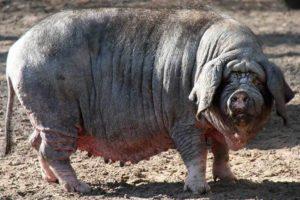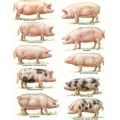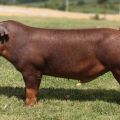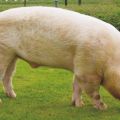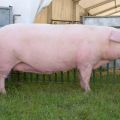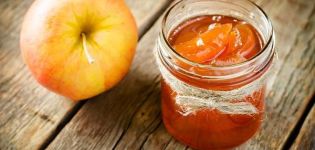Description and features of Danish protest breed pigs, breeding history
The domestication and domestication of pigs began more than 7 thousand years BC. The first domestic pigs were not much different from wild pigs. The centuries-old selection has led to the fact that modern pig breeders raise more than 100 breeds of these animals. For various reasons, some of them are on the verge of complete disappearance. These endangered species include the Danish protest pig or its revived version - the Husum protest red-and-white pig.
Description and characteristics of the breed
The breed differs from the rest with its bright red color. A white stripe runs along the shoulder blades, which captures the forelimbs, dropping down to the very hooves. The hair is thick, the bristles are soft, straight, without curl. It evenly covers the body of the animal.
Exterior features:
- the body is long;
- the shoulder blades are light;
- the sacrum is wide;
- full, well-shaped hams;
- the muzzle is straight;
- hanging ears.
Adult animals that have reached 18 months are characterized by the following parameters:
- height at the withers - up to 85-95 cm;
- the weight of boars is from 400 to 500 kg;
- sows weight - 300-350 kg;
- body length - 160-190 cm;

Females piglet 2 times a year. The average number of piglets per litter is 10-12 at birth and 8-10 at weaning. Slaughter is carried out at the age of 180 days, when young animals reach a weight of 90 kg and a body length of 92 cm. The maximum age for using valuable breeding sows is 10-11 years, for breeding boars - 7-8 years.
Features of Danish pigs
Danish pigs are bacon breeds. Their fat is distributed not only under the skin, but also between the fibers of muscle meat. This occurs in the region of the ridge and on the ventral side. The meat is quite lean, soft and juicy. Compared to other breeds, Danish pigs are quite resistant to most diseases and unpretentious in keeping. Animals give good weight gain when free grazing.
Breeding history
The history of the appearance of the breed is closely related to historical events. In the summer of 1219, during the period of Christianization of the population of Denmark, its king Waldemar II was preparing for an important battle with the pagans. In the evening, the monarch looked up into the sky and saw a white cross in the crimson reflections of the sunset. This is how the Danish flag appeared, called Dannebrog. On his red banner was a Scandinavian cross.

In 1864, after the signing of a peace treaty, Denmark renounced claims to Schleswig, Lauenburg, Holstein. The lands were transferred to Prussia and Austria. Danish patriots living in the annexed lands could not come to terms with this state of affairs and hung the national flag on their houses. For which they were subject to large fines.
To save money and protest the authorities, local pig breeders by the beginning of the twentieth century bred a pig breed that resembled Dannebrog in color.
The true origins of the Danish pigs are not known. According to scientific research, the following breeds were used in breeding:
- Jutland marsh;
- Tamvrot;
- marching Danish;
- red varieties of engeln saddelback.
Breeding peaked in the first half of the 20th century, but the Prussian authorities refused to register the breed. Its recognition took place only after World War II, in 1954. However, after 15 years, interest faded, and after 1968 there are no reliable cases of the birth of piglets of this breed.

View conservation history
The beginning of the revival of the breed is considered to be 1984, when red-and-white piglets were exhibited at the international exhibition in Berlin "Green Week". All animals were purchased by the Berlin Zoo. They formed the basis of breeding work to revive the extinct breed. Communities of unusual pig breeding began to appear.
Since 1996, the process of breeding and pedigree registration has been controlled by the association of lovers of red-and-white Husum pigs, which, although they are not representatives of the Danish protest breed, are very close to it in phenotype. Now they can be seen in several zoos in Germany:
- Berlin;
- Hanover;
- Hamburg.
Today the livestock is 140 individuals. Difficulties in breeding are the selection of pairs in such a way that as a result of crossing, only healthy piglets with a set of certain traits appear.
